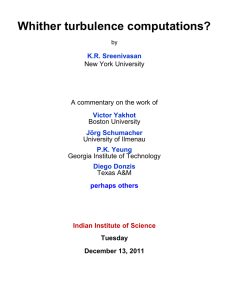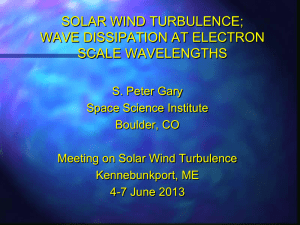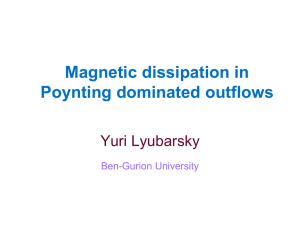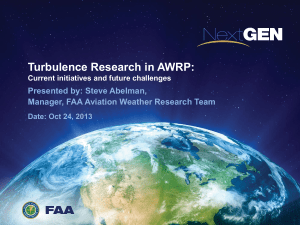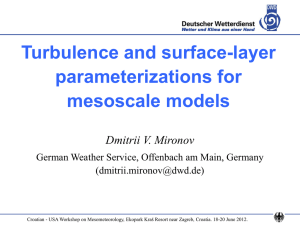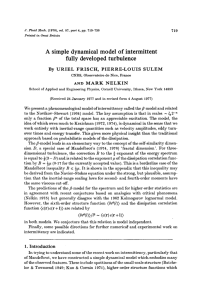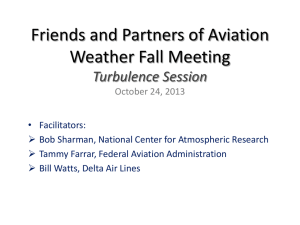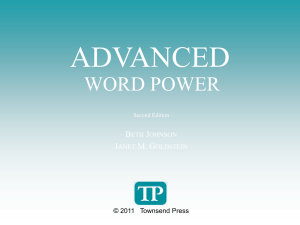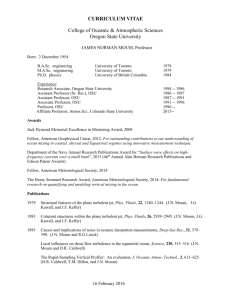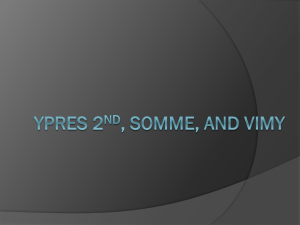Moum_IWISE_POReview2013 - Ocean Mixing Group
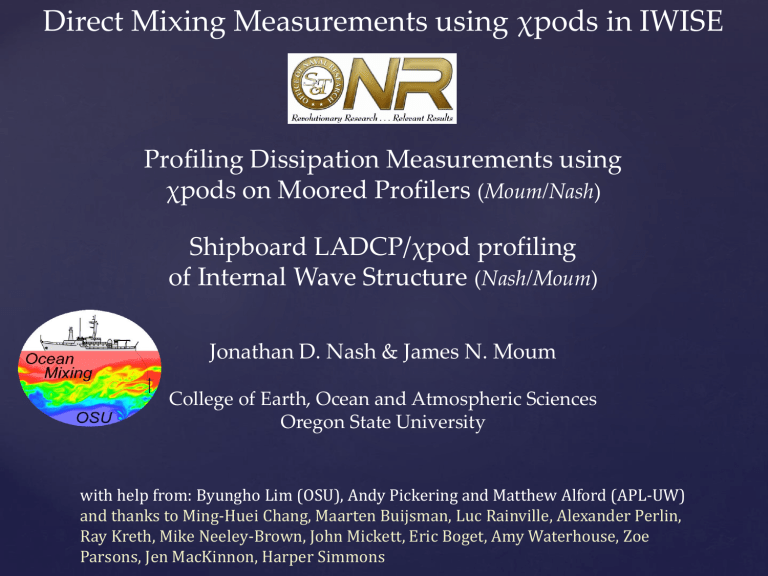
Direct Mixing Measurements using χpods in IWISE
Profiling Dissipation Measurements using
χpods on Moored Profilers (Moum/Nash)
Shipboard LADCP/χpod profiling of Internal Wave Structure (Nash/Moum)
Jonathan D. Nash & James N. Moum
College of Earth, Ocean and Atmospheric Sciences
Oregon State University with help from: Byungho Lim (OSU), Andy Pickering and Matthew Alford (APL-UW) and thanks to Ming-Huei Chang, Maarten Buijsman, Luc Rainville, Alexander Perlin,
Ray Kreth, Mike Neeley-Brown, John Mickett, Eric Boget, Amy Waterhouse, Zoe
Parsons, Jen MacKinnon, Harper Simmons
Objectives
General
• quantify turbulence dissipation where large amplitude internal waves are generated
Particular
• capture the energetics of the largest scales that directly extract energy from the barotropic tides
• while simultaneously measuring mixing associated with the turbulence that occurs at millimeter and millisecond scales.
• through direct observation, to assess the means by which waves form and break, elucidate the structure/evolution of the wave breaking, and quantify the dissipation that induces irreversible mixing
Methods
• χpods on moorings
Stablemoor
Methods
• χpods on moorings
• χpod-like devices on moored profilers
Methods
• χpods on moorings
χpod -LADCP
• χpod-like devices on moored
• χpod on shipboard CTD for full ocean depth turbulence profiling
Methods
• χpods on moorings
• χpod-like devices on moored profilers
• χpod on shipboard CTD for full ocean depth turbulence profiling
• fabricated and deployed 5-component array of moorings to capture the 2D evolution of the largerscale dynamics
Profiling Dissipation Measurements using χpods on Moored Profilers data example fast thermistors on APL MP
Kraichnan theoretical spectrum
{
ε
χ
=N 2 χ/(2 Γ T z
2 )
1 st
Products → continuous deep-ocean profiling experiment
χ
T
T
Refined for 2010 (MPN) nd half
• mesoscale current (Kuroshio?) dominates 2 elevated turbulence at base of current
ε TKE dissipation rate (indirect)
• is this friction on a western boundary
K current?
turbulence viscosity
New mean speed / dissipation sensor for use on χpods and in general on moorings inexpensive, lightweight, low power, standalone velocity sensor
χpod mooring N1 – χpod at 2000 m
1 day time series compensated pitot tube speed sensor at low f dissipation sensor at high f
ε=2x10 -7 m 2 s -3 leading to a new GustT combination probe not acoustic, hence requires no scatterers quiet characterization of sensor includes tests in
• wind tunnel
• tidal channel
• P / T chambers
2 nd continuous deep turbulence profiling time series
N2 (1830m water depth)
2011
2 units constructed and deployed – both worked
– only 1 MP profiled
Chipod-LADCP-CTD
fast-T
3-axis accel
3-axis gyro compass
USB-data
Nash & Moum
OSU Ocean Mixing χ-pod/LADCP
direct measurements of abyssal turbulence from standard shipboard
CTD.
permits rapid deep profiling
direct turbulence differs from that inferred from overturns
low noise-floor (but N 2 -dependent) inferred turbulence
(blue) direct turbulence
(green)
Above: TKE dissipation rate from
LADCP/chipods (green) and Thorpe analyses
(blue) at one of the most energetic stations sampled during IWISE.
contrasting structures from detailed measurements at 2 ridges
1) broadly-distributed dissipation on the east ridge
2) big breaking lee waves on the west ridge west
MP chipods east
A1 – mid-column dissipation at the generation site
1440 m water depth mid-column dissipation not dominated by a single breaking wave…
Byungho Lim
A1 – mid-column dissipation at the generation site observation / model comparison (MITgcm / Buijsman) similar tidal fields, but water-column instabilities are not captured by MITgcm and model dissipation is mostly near the bottom.
Byungho Lim
T-Chains on the
West Ridge
Jonathan Nash
T1
T2
N2
Buijsman et al
T3
T4
30-50 m sensor spacing to detect overturns
2-sec sampling to capture inertial subrange
Vertical synopticity (test sampling schemes of other platforms)
3 months data
700 m waves eastward westward west
500 m overturns east
T-Chains on the
West Ridge spring tides / diurnal inequality
T1
T2
N2
T3
T4
Mooring T3 during spring
+ diurnal inequality
T-Chains on the
West Ridge neap tides / semidiurnal period
T1
T2
N2
T3
T4
Mooring T3 during neap/semidiurnal period
Time – mean structure / east ridge
Springs
(diurnal)
T1
T2
N2
T3
T4
Dissipation tied to lee waves
Strong spring/neap changes
Isopycnals displaced down in the mean?
Lee-wave shifts closer to ridge crest during neaps?
Neaps
(semidiurnal)
Dissipation evolution and scaling
ε~ u 3 bt
T1
T2
T1
T2
N2
N2
T3
T3
T4
T4
dissipation scales with u 3 bt
(nonlinear!)
consistent with Klymak et al
(2010)’s “recipe” for ε over a supercritical ridge
… u 3 because flux into trapped lee waves ~( u bt x u 2 bt
) …
Summary Results
• 1 st continuous turbulence profiling away from ship-based upper ocean measurements
• χpod-CTD measurements have led to beginning of contribution to Global Repeat Hydrogaphy Program
• NEW VELOCITY SENSOR - speed + turbulence leading way to new possibilities
• observational confirmation of Klymak etal (2010) ε scaling
• breaking waves: vertically-integrated ε O(1 W/m 2 ) comparable to flux divergence 5 kW/5 km suggests significant local dissipative losses
• vertically-distributed turbulence may be difficult to model but significant to water mass mixing through vertical flux divergence
Summary Results
continued contributions to NRL field science
MORT Mixing Over Rough Topography
BWE Breaking Wave Effects in High Winds technological:
• loan of OSU-developed instrumentation
• technical-level analysis scientific:
• participation in science-level analysis
• contribution to publications
Moored profiler χpod estimates of turbulence dissipation rate, ε
L
T
– large-eddy length scale statistic simply computed from 1D profiles
- but an imperfect statistic in an evolving 3D field
L o
– large-eddy length scale defining buoyancy limit on turbulence
L o
= √(ε/N 3 ) if L
T
= L o
, then ε = L
T
2 N 3 is L
T
= L o
?
Moored profiler χpod estimates of turbulence dissipation rate, ε
L
T
– large-eddy length scale statistic simply computed from 1D profiles
- but an imperfect statistic in an evolving 3D field
L o
– large-eddy length scale defining buoyancy limit on turbulence
L o
= √(ε/N 3 ) if L
T
= L o
, then ε = L
T
2 N 3 same data – different definition of N 2 is L
T
= L o
?
pod
How do we know χpods work?
Equatorial Internal
Wave Experiment 2008
7 χpods on EQUIX mooring yields 7 time series of χ, ε
16-day experiment at 0, 140W
Oct/Nov 2008
24h continuous profiling of χ, ε
6-10 profiles/h
5 χpods on TAO mooring yields 5 time series of χ, ε
Perlin & Moum, 2012 JAOTech
pod
χ
How do we know χpods work?
ε
profiler
χpods
χpods
Perlin & Moum, 2012 JAOTech
Comparison of ε computed from χpod and from pitot tube
A1 – mid-column dissipation at the generation site
Observation / model comparison at T3
Observation / Model comparison at T3
Andy Pickering
model does a pretty good job with the vertical distribution and daily-averages
details are a little different
Andy Pickering
MITgcm / Buijsmann et al 2013
Dissipation evolution / compare to MITgcm
T1
T2
T1
T2
N2
N2
T3
T3
T4
T4
First continuous deep turbulence profiling time series
MP-N 2010 mesoscale current (Kuroshio?) dominates 2 nd half elevated turbulence at base of current is this friction on a western boundary current?
T-Chains on the spring diurnals vs. neap semidiurnals
West Ridge diurnal composite / spring semidiurnal composite / neap
Summary Results
Distributed Mixing
(detached from bottom) is difficult to model
Conclusions
its vertical distribution?
Can we assign error bounds on model ε?
Integrated Dissipation from big breaking waves contributes O(1 W/m 2 ) vertically-integrated ε this suggests ΔF
ε
= 5 kW/m in 5km…
ε is significant to F
E
!
ε~ u 3 bt
ε~ u 3 bt
Buijsman et al log
10
ε observed


